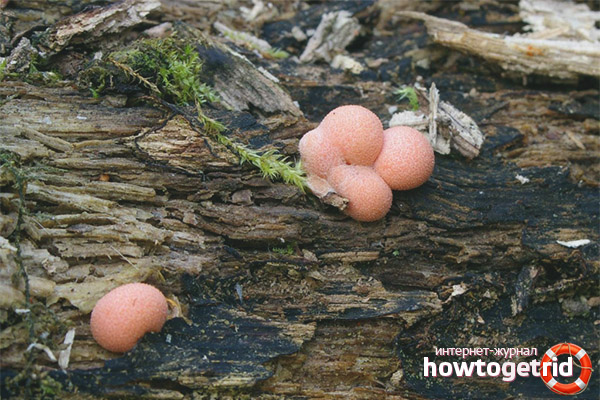The content of the article
Lycogala is an inedible mushroom species belonging to the reticular family. The Latin name for this mushroom is Lycogala epidendrum. Most often, mushroom pickers call this species as slug or wolf milk / udder.
In fact, lycogal is a type of mold that parasitizes on different surfaces (soil, wood) in places characterized by high humidity. This parasitic species of fungi is capable of movement.
Description of the species
Wood licorice - although it is a mushroom, nevertheless it is also, in fact, a type of mold, leading a parasitic lifestyle. In appearance, the mushroom is very similar to a rain coat, but only of modest size. The shape of the fruiting body of the slyshevik is spherical, the maximum diameter reaches 20 mm. The color of the fungus ranges from pinkish to saturated brown (the older the fungus, the darker the color of its fruit body). Young specimens to the touch have a rather soft and delicate structure.
The surface of the mold fungi is scaly, the inside of the lycogalum is filled with a pink-red liquid, and when pressed on the fruit body, this liquid is sprayed. A fully matured specimen highlights colorless spores that go out through the opening of the upper body of the fungus.
Where the species grows
Lycopal woody is a common type of mushroom that can be found in the forests of our country. Most often, the slug grows in wet and dark places. In addition to the fact that the main place of growth of the fungus is decaying and old wood, often the wolf's udder can be seen on the deadwood.
Peak fruiting representatives of this species - from the beginning of the summer until the beginning of autumn. In dry seasons, mushrooms begin to bear fruit earlier.
Breeding species
As already mentioned above, woody lycogalus cannot be considered a full-fledged fungus, since this organism is characterized by signs of both fungi and amoebas. During dry periods, when the fungus lacks nutrients, it accumulates all its strength for the continuation of the species. For this, this parasite that slowly moves the fungus selects the most sunny place for subsequent reproduction (the appearance of a large number of fruit bodies in the form of balls). When these balls and the liquid inside them dries, the latter break up into many disputes, which, in fact, in the future will give life to the new offspring.
For a sputum spore, one drop of water is enough to form microscopic cells that do not have a shell as such. Each such cell consists of a nucleus and the surrounding protoplasm. The main property of such a cellular structure is a rather rapid division, the constantly increasing number of them forms the characteristic mucous mass (plasmodium). At the next stage of development, the plasmodium begins to slowly move in the right place for its subsequentdevelopment direction, after which it forms new fruiting bodies with a bubbly surface.
Virulence
Wolf udder mushrooms belong to inedible species and, accordingly, they are absolutely unsuitable for food. It is also not recommended to touch, squeeze and smell mushrooms of this species, since there is an opinion that the spores of this mushroom can accumulate in themselves many pathogens dangerous for human health.
Interesting Facts
According to some reports, such a mushroom as lycogalo can also develop in the human body. This type of fungus is especially dangerous during dry seasons when, due to the lack of necessary food (wood), lycogalum does everything so that its offspring live.
The offspring of the fungus - single-celled live parasites, which, in fact, are the same Trichomonas at different stages of development.
Often, this fungus is the cause of such diseases as deep mycoses, in addition, it can provoke such serious enough pathologies as infective endocarditis, rheumatoid arthritis and even cancer.
It is rather difficult to diagnose the disease caused by this fungus parasite, since it often masks as other infectious diseases.The most important in the treatment of diseases caused by the fungus parasite lycogalla that entered the human body is timely and accurate diagnosis, only in this case the treatment will give positive results.
Video: Lycogala (Lycogala epidendrum)












To send